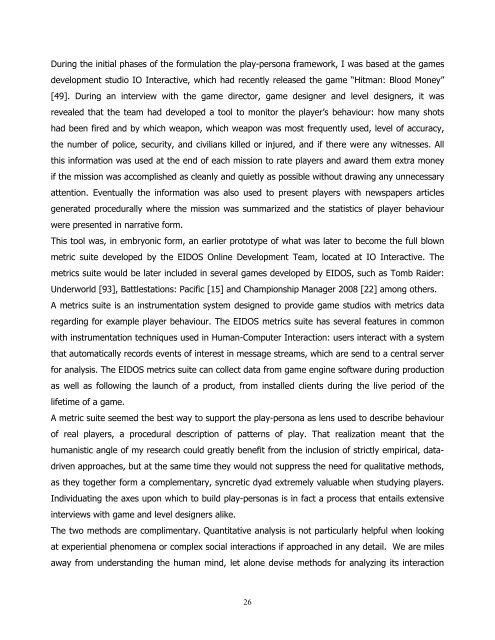Play-Persona: Modeling Player Behaviour in Computer Games
Play-Persona: Modeling Player Behaviour in Computer Games
Play-Persona: Modeling Player Behaviour in Computer Games
You also want an ePaper? Increase the reach of your titles
YUMPU automatically turns print PDFs into web optimized ePapers that Google loves.
Dur<strong>in</strong>g the <strong>in</strong>itial phases of the formulation the play-persona framework, I was based at the games<br />
development studio IO Interactive, which had recently released the game “Hitman: Blood Money”<br />
[49]. Dur<strong>in</strong>g an <strong>in</strong>terview with the game director, game designer and level designers, it was<br />
revealed that the team had developed a tool to monitor the player’s behaviour: how many shots<br />
had been fired and by which weapon, which weapon was most frequently used, level of accuracy,<br />
the number of police, security, and civilians killed or <strong>in</strong>jured, and if there were any witnesses. All<br />
this <strong>in</strong>formation was used at the end of each mission to rate players and award them extra money<br />
if the mission was accomplished as cleanly and quietly as possible without draw<strong>in</strong>g any unnecessary<br />
attention. Eventually the <strong>in</strong>formation was also used to present players with newspapers articles<br />
generated procedurally where the mission was summarized and the statistics of player behaviour<br />
were presented <strong>in</strong> narrative form.<br />
This tool was, <strong>in</strong> embryonic form, an earlier prototype of what was later to become the full blown<br />
metric suite developed by the EIDOS Onl<strong>in</strong>e Development Team, located at IO Interactive. The<br />
metrics suite would be later <strong>in</strong>cluded <strong>in</strong> several games developed by EIDOS, such as Tomb Raider:<br />
Underworld [93], Battlestations: Pacific [15] and Championship Manager 2008 [22] among others.<br />
A metrics suite is an <strong>in</strong>strumentation system designed to provide game studios with metrics data<br />
regard<strong>in</strong>g for example player behaviour. The EIDOS metrics suite has several features <strong>in</strong> common<br />
with <strong>in</strong>strumentation techniques used <strong>in</strong> Human-<strong>Computer</strong> Interaction: users <strong>in</strong>teract with a system<br />
that automatically records events of <strong>in</strong>terest <strong>in</strong> message streams, which are send to a central server<br />
for analysis. The EIDOS metrics suite can collect data from game eng<strong>in</strong>e software dur<strong>in</strong>g production<br />
as well as follow<strong>in</strong>g the launch of a product, from <strong>in</strong>stalled clients dur<strong>in</strong>g the live period of the<br />
lifetime of a game.<br />
A metric suite seemed the best way to support the play-persona as lens used to describe behaviour<br />
of real players, a procedural description of patterns of play. That realization meant that the<br />
humanistic angle of my research could greatly benefit from the <strong>in</strong>clusion of strictly empirical, data-<br />
driven approaches, but at the same time they would not suppress the need for qualitative methods,<br />
as they together form a complementary, syncretic dyad extremely valuable when study<strong>in</strong>g players.<br />
Individuat<strong>in</strong>g the axes upon which to build play-personas is <strong>in</strong> fact a process that entails extensive<br />
<strong>in</strong>terviews with game and level designers alike.<br />
The two methods are complimentary. Quantitative analysis is not particularly helpful when look<strong>in</strong>g<br />
at experiential phenomena or complex social <strong>in</strong>teractions if approached <strong>in</strong> any detail. We are miles<br />
away from understand<strong>in</strong>g the human m<strong>in</strong>d, let alone devise methods for analyz<strong>in</strong>g its <strong>in</strong>teraction<br />
26















